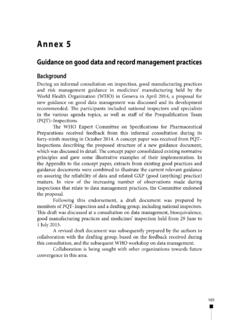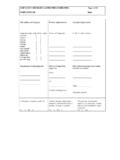Transcription of Understanding Objective Evidence: (What It Is and What It ...
1 EDUcation: QUality Engineering, Science and Technology 1896 Urbana Pike, Suite 14, Hyattstown, MD 20871 USA, Ph: 301-874-6031, 1 EduQuest Advisory, November 2011, Understanding Objective Evidence: (What It Is and What It Definitely Is Not) By Denise Dion, Vice President of Regulatory and Quality Services, EduQuest (18-year veteran of the FDA, former senior FDA investigator) The following article first appeared in the Spring 2011 issue of the Journal of Validation Technology Learn what common industry practices don t result in Objective evidence Review business, scientific and legal definitions of Objective evidence Understand the basic concepts behind the scientific method Review test protocols to ensure they result in true Objective evidence Examine FDA expectations for Objective evidence As you likely know, computer system validation requires Objective evidence evidence that proves the results of a particular system will be consistent throughout its operating lifetime.
2 But do you really understand what constitutes Objective evidence from a scientific and a legal perspective, and of great importance to those subject to regulatory inspections, from the perspective of the Food and Drug Administration (FDA)? What Objective Evidence is NOT Let s answer the question by first Understanding what Objective evidence is not. The words pass , fail , yes , no , as expected , true and false are not and never will be Objective evidence. They are conclusions. Conclusions are what you make based on what you believe the Objective evidence shows. Instead, Objective evidence is what you observed, what actually happened, or what did not happen. In science, we document Objective data as well as test methods so that others can perform the same tests and compare their results ( Objective evidence) to ours. That s the essence of Objective evidence. With this approach, others can objectively determine whether our conclusions are valid.
3 EDUcation: QUality Engineering, Science and Technology 1896 Urbana Pike, Suite 14, Hyattstown, MD 20871 USA, Ph: 301-874-6031, 2 Useful Definitions from Different Perspectives It may be helpful to see how different disciplines approach the concept of Objective evidence. Here are some example definitions of Objective evidence from various literature sources and perspectives: From a business perspective: Objective evidence is information based on facts that can be proved through analysis, measurement, observation, and other such means of research. From a legal perspective: Objective evidence is real evidence, also known as demonstrative or Objective evidence; this is naturally the most direct evidence. From a scientific perspective: To be termed scientific, a method of inquiry must be based on gathering observable, empirical, and measurable evidence subject to specific principles of reasoning.
4 A scientific method consists of the collection of data through observation and experimentation, and the formulation and testing of hypotheses. From a list of Plain English definitions related to the ISO 9000, 9001 and 9004: Objective evidence is data that show or prove that something exists or is true. Objective evidence can be collected by performing observations, measurements, tests, or by using any other suitable method. Basic Expectations of the Scientific Method In science, we know procedures will vary from one field of inquiry to another. There are, however, identifiable features that distinguish scientific inquiry from other methods of knowledge. Scientists propose hypotheses as explanations of phenomena, then design experiments to test those hypotheses. The methods scientists use must be repeatable so that someone else, using the same methods, can dependably predict future results. Theories may encompass wider ranges of inquiry and may combine many hypotheses together in a coherent, supportive whole.
5 This consolidation in turn may help other scientists form new hypotheses or place groups of hypotheses into context. The processes used in scientific inquiry must be Objective to reduce and preferably eliminate biased interpretations of the results. Another basic expectation of the EDUcation: QUality Engineering, Science and Technology 1896 Urbana Pike, Suite 14, Hyattstown, MD 20871 USA, Ph: 301-874-6031, 3 scientific process is that you always document results, maintain the supporting data, and share all data and methodology thus allowing careful scrutiny by other scientists. As a result, other scientists have the opportunity to verify results by attempting to reproduce them. This practice is known as full disclosure and allows scientists to establish statistical measures of the data s reliability. The scientific method can never absolutely prove the truth of any hypothesis. It can only falsify the hypothesis.
6 That s what Einstein meant when he said, No amount of experimentation can ever prove me right; a single experiment can prove me wrong. Review Your Test Protocols for Bias It s human nature to try to prove our own hypotheses are correct. But our beliefs can alter our observations. We re prone to what s known as the human confirmation bias. This bias is called a heuristic* something that leads persons with a particular belief to see things as reinforcing that belief, even if another observer would disagree. (*A heuristic is a rule of thumb, an educated guess, an intuitive judgment, or simply common sense. A heuristic is a general way of solving a problem.) To help eliminate this natural bias, science demands we test hypotheses by attempting to disprove them. This approach isn t always practical in industries regulated by the FDA, but we still should try to remove all bias from our validation efforts. A typical hypothesis for a computer system validation is My installed system for [whatever the function] will consistently, reliably, and reproducibly produce data or perform as described in the requirements, given the defined hardware, software, procedures, and personnel.
7 Our validation protocols likely are written to help prove the validity of this statement. But the way we write those protocols will determine how much and what kind of Objective data we get. Providing the expected results up front (beforehand) to the tester is not the optimum method to obtain true Objective evidence. Yes, we as validation professionals need to know the expected results (acceptance criteria), but remember it s the reviewer of the Objective evidence not the tester who must know those criteria. Otherwise, the human confirmation bias of the tester may prevail and dilute your confidence in the objectivity of test results. EDUcation: QUality Engineering, Science and Technology 1896 Urbana Pike, Suite 14, Hyattstown, MD 20871 USA, Ph: 301-874-6031, 4 Review Your Test Protocols for Efficiency Often protocols are written to provide Objective data at each step in the protocol. Because of this, we often see protocols that look like those in the Table below: Table 1: Validation Protocols Step # Process Step Expected Result Actual Result Pass/Fail 1.
8 Turn on computer Turns on As expected Pass 2. Log-in Allows log-in As expected Pass 3. Main menu displays Main menu displays As expected Pass In this example, what matters is that the Main menu displays after the appropriate log-in. The fact that the system will turn on and allow the tester to log-in is supported by the fact that the Main menu displays. Obviously, the Main menu won t display if the computer doesn t boot up and allow the tester to log-in. So in this case, the Objective data only need to be obtained at Step #3. A screen print at that point provides Objective data that shows Steps #1 through #3 have been executed correctly. Of course, there may be multiple steps in any given test protocol. But you may find data generated or displayed at those various steps proves a wider portion of the system is performing as designed. So you can be more efficient in developing Objective evidence by documenting only the data that truly reflects the system will function as designed or intended.
9 FDA Requirements for Objective Evidence FDA is a science-based law enforcement agency and, therefore, requires answers that are scientifically and legally supported. FDA expects your Objective data to answer the following questions: Scientific Can the data be evaluated by independent observers to reach the same conclusions? Scientific Are the data documented in a manner that allows re-creation of the data or the events described? Scientific Does the documented evidence provide sufficient data to prove what happened, when, by whom, how, and why? EDUcation: QUality Engineering, Science and Technology 1896 Urbana Pike, Suite 14, Hyattstown, MD 20871 USA, Ph: 301-874-6031, 5 Legal Was the documentation completed concurrently with the tasks? Legal Is the documentation attributable (directly traceable to a person)? Legal Have the data and associated documentation been maintained in a manner that provides traceable evidence of changes, deletions, additions, substitutions, or alterations?
10 Legal Are the data and associated documentation maintained in a manner that protects and secures them from changes, deletions, additions, substitutions, or alterations? Additional FDA Expectations FDA also expects you to follow good documentation practices. That means your data must be clear, legible, indelible, and documented concurrently. FDA expects your documents and records to be complete, dated, signed, reviewed, and approved (if applicable). Furthermore, the Agency expects you to maintain regulated documents and records in formal, approved document management systems. FDA investigators will look for evidence of data changes. So you should note any written changes using a single cross-out, with appropriate date and initials. If your data is in electronic format, FDA will look for a clear audit trail traceable from all fields. For good laboratory practices, FDA also will expect you to include the reason(s) for any change.






